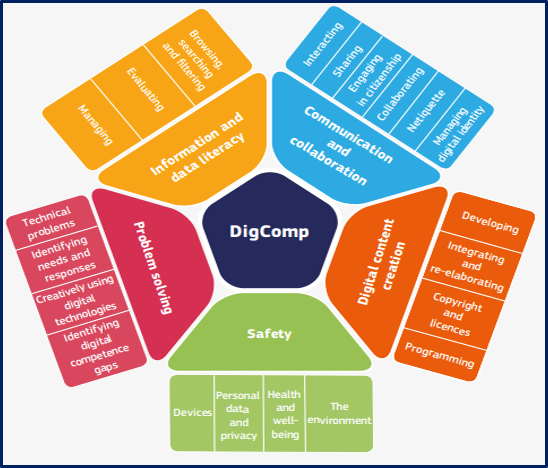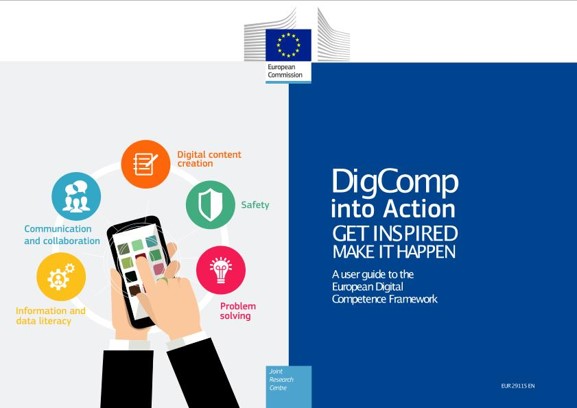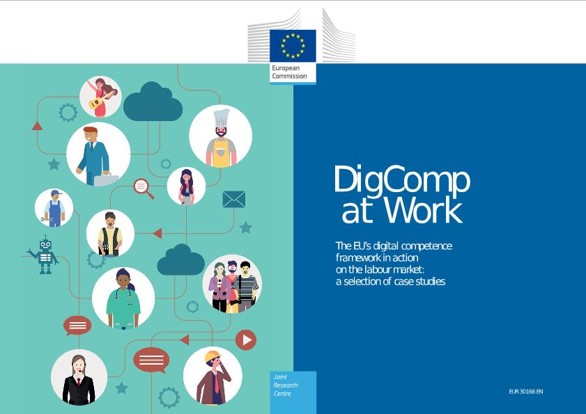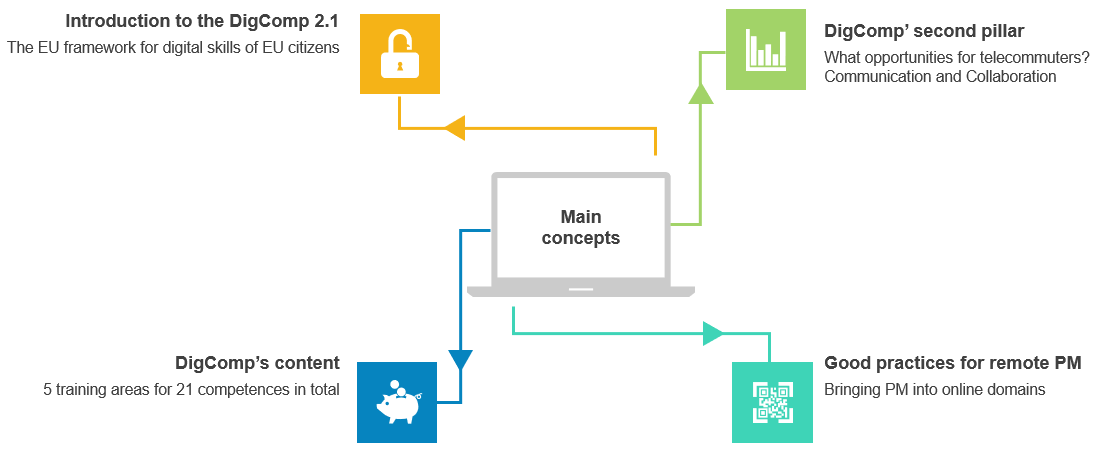|
Introduction
Introducing the DigComp Framework
Introduction to the DigComp
In 2013, the European Commission published the European Digital Competence Framework for Citizens (a.k.a. DigComp): a tool conceived as a teaching and training models to empower and strengthen EU citizens’ digital skills and proficiency with IT systems.
In the years following its publication, the framework gathered incredible success among Member States and it has been relied on as a very robust tool to design content and structure of national and cross national training programme with focus on many different operational settings (i.e., education and training, private sector and employment).
Background, the DigComp 2.0
Since the beginning of the last decade, digital technologies evolved at exponential rates. In view of the new context, the European Commission promoted an updated revision of the DigComp that came in 2016 with the DigComp 2.0: a conceptual reference model of 21 competences divided among five strategic areas of training, and foreseen as the very “essential” of digital literacy.
The scale and scope of DigComp 2.0 (and following revisions) are essentially three:
- Support better informed policy interventions in the domain of digital citizenship
- Support better informed training curricula at both formal and informal level
- Support better informed evaluation models for the assessment of learning outcomes
The 2016’s revision of DigComp was already anticipated by the 2.0 version.
More in general, the DigComp 2.1 gives further continuity to a research area that is of JRC’s interest since 2005 and it is focused on:
- Rethink learning through the exploitation of ICT
- Innovating education curricula to address the new demand of digital competences in the labour market
- Favour better equal opportunities for socio-economic inclusion and employability.
About the 21 Competences – a visual representation
In the 2.1 version, each of the 21 competence is further classified based on a 8-level evaluation model that is conceived to identify with more precision learning outcomes and key skills that learners are expected to acquire to strengthen and foster their digital expertise.

DigComp 2.1 – training areas and competences
|
1. Information and data literacy
|
2. Communication and collaboration
|
3. Digital content creation
|
4. Safety
|
5. Problem Solving
|
- 1.1 Browsing, searching and filtering data, information and digital content
- 1.2 Evaluating data, information and digital content
- 1.3 Managing data, information and digital content
|
- 2.1 Interacting through digital technologies
- 2.2 Sharing through digital technologies
- 2.3 Engaging in citizenship through digital technologies
- 2.4 Collaborating through digital technologies
- 2.5 Netiquette
- 2.6 Managing digital identity
|
- 3.1 Developing digital content
- 3.2 Integrating and re-elaborating digital content
- 3.3 Copyright and licences
- 3.4 Programming
|
- 4.1 Protecting devices
- 4.2 Protecting personal data and privacy
- 4.3 Protecting health and well-being
- 4.4 Protecting the environment
|
- 5.1 Solving technical problems
- 5.2 Identifying needs and technological responses
- 5.3 Creatively using digital technologies
- 5.4 Identifying digital competence gaps
|
DigComp for telecommuters
“Communication & Collaboration”
If we go back to the table in Section 1.2, we will notice that although all pillars detain extreme relevancy for telecommuters, Communication & Collaboration gains particular significance for those organisations/teams invested in large scale projects impacting and/or involving several external parties.
Remote working prevents project managers from quick exchange of information with colleagues and staff members in general, reducing their efficacy (and effectiveness) in carrying out their activates. Moreover, meeting and coordinating with partners/clients from remote can generate misconceptions since the communication is limited to the verbal channel only.
The competences of the second DigComp's training area
Considering the scale and scope of traditional project management activities, interacting, sharing and collaborating through digital technologies (respectively, competence no. 2.1, 2.2 and 2.4) are essential technical competences for in-remote project managers.
On the other hand, netiquette and managing the digital identity (respectively, competence no. 2.5 and 2.6) become fundamental soft competences to validate in the eyes of an outsider one’s own values, reputation and reliability – as people would normally seek to do in person.
Exploiting the DigComp in your favour
As of today, the DigComp 2.1 remains one of the most (if not THE most) comprehensive framework for the assessment and evaluation of IT readiness and responsiveness of common citizens and well as public administrations and private organisations.
The first thing you might trying do is self-assessing, by your own or with your project team, what is your current proficiency level with Collaboration & Cooperation competences for remote working and remote project management.
Interacting through digital technologies
Sharing through digital technologies
Collaborating through digital technologies
Managing digital identity
How can you make further use of the DigComp?
The application potentials of the DigComp 2.1 are very wide and diverse.
As a matter of facts, in 2018 and 2020, the European Commission published two official follow-up intended to mainstream and showcase EU and cross-national best practices in the implementation of the DigComp in educational settings (DigComp Into Action) and private businesses (DigComp At Work).
Out of the two, you will be particularly interested in the second, as it tackles numerous challenges that are typically addressed by private organisation at the edge of their digital transition.
Best practices in the implementation of the DigComp 2.1
Click on the images the consult the reports
Further hints for remote PM
General facts about remote project management
There is no doubt that remote project management comes with both benefits and disadvantages:
|
BENEFITS
|
DISADVANTAGES
|
- In general, smart working it is proven to increase productivity and job satisfaction
- Reduced turnover of employees
- Extended talent pool
- Better networking opportunities
- Increased savings
- Higher employment engagement
|
- Entropy and excessive information redundancy
- Lack of cohesions and trust-based relationship among employees or/and employees and employers
- Loss of overview
- Weakening of communicant flow
- Overlapping schedules
- Video calls fatigue
|
Capitalising on benefits while containing negative impacts
There are several ways in which project managers can secure benefits and employees’ satisfaction from the negative outcomes that might come with remote working.
In general, it has been observed that smart working produces positive impacts as long as:
- Organisation are successful in fostering and maintaining a trust-based culture
- Employers avoid micromanagement attitudes
- Employees find better opportunities for work-life balance
If only one out of the aforementioned conditions start missing, the organisation starts experiencing higher level of stress and unproductivity.
In the next few slides, readers can find a checklist of tips and tactics that help in sustaining this delicate balance.
List of good-practices for remote project management
- Start by setting-up adequate remote project management tools that are intuitive, user-friendly and easy to access
- Take a step-back and allow your team to manage their time. You will be fine as long as they manage to comply with internal deadlines
- Be as precise as possible when assigning a tasks. Most of communication will happen via email/text, which by nature, leave more room for misinterpretations
- Same for feedbacks and revision guidelines
- Know your employees and redistribute roles and responsibilities
- Establish specific communication channels – but do not overflow them of inputs
- Make sure that communication is transparent and efficient. Set a commonly agreed calendar of “briefing” calls
- Nurture a collaboration culture. Consider to set up new file storage systems that everyone can easily access to
- Monitor key milestones’ achievements and inform your team in advance about any recommended adjustment
- Check on your time, not only to seek about the status of their work…
- Intercept any potential conflict that might emerge between two (or more) of your employees
- Capitalise on your team’s internal diversity, leave room for self-initiative and brainstorm with your people on never-considered-before alternatives to common issues
Summing up
|


 Demo
Demo Play Audio
Play Audio 














